#gond art blogs
Explore tagged Tumblr posts
Text
What are the origins of Gond Art?
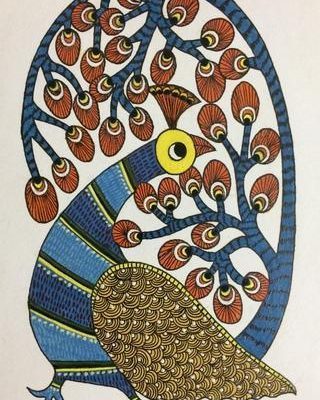
Gond Art is a folk tribal art form practiced by arguably the largest tribe in Central India. The art form today is expanding many new horizons and has acquired a cult following in Indian art connoisseurs. The tribes involved in this art form predominantly hail from Madhya Pradesh and parts of Chattisgarh, Odisha, Andhra, Telangana Maharashtra. Although we mainly associate it with these pockets this art form with time has acquired a pan-Indian appeal and enhances the rich heritage India takes pride in. Let us discuss how this rich tradition grew. From where it all started The recorded history of Gond Art goes back to as many as 1400 years. The areas where we find its traces have also been identified with rock paintings from the Mesolithic age. Since there is a very evident stylistic and thematic influence of Mesolithic paintings in Gond Art, who knows probably their legacy dates back even further? The Gonds trace their roots back to the Pre-Aryan age and anthropological sources identify them as Dravidians. The dialect they speak is also heavily influenced by Telegu and other Dravidian languages. Why Gond? The word Gond comes from Kond in the Dravidian idiom which means green mountains No wonder why nature is such an integral thematic stylistic element in Gond Art with the recurrent depiction of motifs like trees, leaves, animals, birds, fishes, fish scales, drops of water and primitive human figurines. Gond Art's existence is so much intertwined with nature that paintings for them are an offering to the worship of nature and a divine medium for seeking protection and warding off evil. Values beliefs: The Koi or Koiture what the Gonds call themselves, traditionally hold the belief that a good image begets good luck. This explains why Gond Art for the Kois wasn't just a recreational pastime but a part of their lifestyle. They decorated the walls and floors of their houses with traditional motifs and tattoos. The paintings were influenced by Mahari Devi, Phalvari Devi (Goddess Kali), local flora fauna and were made on festive occasions like Karwa Chauth, Ashtami Nag Panchami. Colors painting style: The Gond painting uses bright vivid colors like yellow, red, blue, and white. These days due to the paucity of natural colors the Gond paintings we see are made by poster colors on the canvas, however, traditionally the colors were derived from charcoal, colored soil, plant sap, mud, flowers, leaves, and cow dung. The extensive use of straight lines that we see in Gond Art is used to convey a sense of movement and add motion to the still paintings. The use of dots dashes enhances the illusion of motion and increases the scope for depicting things in detail. Gond Art in form and the range of subjects it derives its art out of celebrates the rich heritage of India. It is important that we promote it and reinvent it in our aesthetic choices and preferences. Artists like Suresh Kumar Dhurve, Kalam Patua, and Balua Devi through their paintings are taking this art form to a global platform. We have gained enough that the world has had to offer us, it's high time that we now look within our rich and vibrant cultural heritage. Penkraft conducts classes, course, online courses, live courses, workshops, teachers' training & online teachers' training in Handwriting Improvement, Calligraphy, Abacus Maths, Vedic Maths, Phonics and various Craft & Artforms - Madhubani, Mandala, Warli, Gond, Lippan Art, Kalighat, Kalamkari, Pichwai, Cheriyal, Kerala Mural, Pattachitra, Tanjore Painting, One Stroke Painting, Decoupage, Image Transfer, Resin Art, Fluid Art, Alcohol Ink Art, Pop Art, Knife Painting, Scandinavian Art, Water Colors, Coffee Painting, Pencil Shading, Resin Art Advanced etc. at pan-India locations. With our mission to inspire, educate, empower & uplift people through our endeavours, we have trained & operationally supported (and continue to support) 1500+ home-makers to become Penkraft Certified Teachers? in various disciplines.
1 note
·
View note
Text
Directory
To look for a specific word, go to the blog home page and use the search feature on the upper left. You can also type dailygondi.tumblr.com/tagged/[English word] or [Gondi word in Latin script] into your url bar.
Posts specific to the blog itself will be tagged about daily Gondi blog.
To see all posts about Gondi in chronological order, look under daily Gondi.
To see a specific type of post about Gondi in chronological order, see: Grammar | Vocab - single words | Vocab - phrases.
Most Gondi is taken from Gondi Grammar and Vocabulary by Rev. H. D. Williamson, M. A., published in 1889. This book is in the public domain and can be viewed or downloaded for free here: https://digital.soas.ac.uk/RB00000065/00001.
If you know of any better or more current Gondi grammar and/or vocab source, please send us an ask!
Useful Links
Gond on the Academy of Tribal Languages and Culture
The Gondi People on Wikipedia
Endangered Alphabets: Gondi has three alphabets that are endangered
Gunjala Gondi Lipi Script on Wikipedia
Gondi (language) on Wikipedia
Gondi langues and alphabets on Omniglot
Aheri Gondi numbers on Omniglot
Gond Art in Madhya Pradesh
Living in the Shadow of Rebellion: India's Gond Tribe, on Al Jazeera
Gondi language Facebook group
If you have any resources on Gondi grammar, vocabulary, or script, or if you run a related blog, please send us an ask or submit a post!
6 notes
·
View notes
Note
Thought Experiment!
Imagine if there was an anon with nothing but MSPaint, no art knowledge and the will of a dying star....
What does Asheera look like if someone would want to draw her? And if I maybe so bold to ask.....as detailed as you'd deem reasonably possible?
Here's some art that a very lovely person gifted me (artist tagged there) You can use that for reference if you'd like, since she matched exactly what I had in mind!
And I'm 99% sure the "oc: asheera" tag has a WIP Wednesday post where I went into detail vis-a-vis height/weight/eye & hair color. But for reference if you can't find that post:
Dark olive green skin
Black hair with light streaks of blue (thanks for that, Gond)
Slightly reddish brown eyes ("ruddy" in fics)
I'd be ecstatic to have any art of her - sketches, masterpieces, whatever. It would be a cherished gift. I'd just ask, in general for any other wild minds, to tag me and list me as the creator of the OC if any art is posted separately from this blog 💜
2 notes
·
View notes
Text
10 Aspects of Cheriyal Paintings
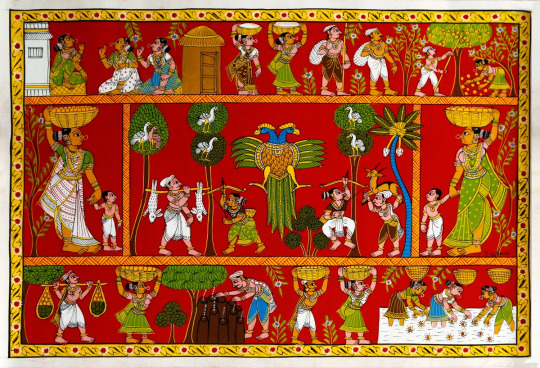
Have you heard about Cheriyal Paintings? If you are an Indian folk art aficionado, you might have; but most of us, unfortunately, do not know much about the art form. In this blog, let’s try learning ten aspects of this Cheriyal painting tradition.
What are Cheriyal Paintings? Cheriyal paintings are long narrative scroll paintings that serve as visual aids to a musical storytelling tradition. A conventional Cheriyal scroll is vertical and is divided into different frames, with each frame depicting a scene from the tale that is being presented. Since these scrolls are meant to be rolled when not in use, they are made with fabric. Traditionally, a khadi cloth is used as the base for these paintings.
Where do they come from? The name that the art form is known by today, i.e., Cheriyal, is derived from the town it is currently practised in. Cheriyal is a town in the Siddipet district of Telangana, India. The practice of the art form is much more limited than it was previously. Initially, these paintings were known as nakash or naqash, which translates to a drawing or a sketch.
Who are the people who are associated with these scrolls? In addition to the previous aspect, the people involved in the creation of these traditional nakash or Cheriyal paintings, are a community known as the Nakashis. Other than this community, there is another important group of individuals associated with this tradition. It is important to note that the actual purpose of these scrolls was to serve as visual aids when a storyteller narrated a particular folklore or mythological story in the form of a song. This community of balladeers is referred to as kaki padagollu. They travel from village to village narrating these stories.
How old is the Cheriyal painting tradition? As mentioned before, Cheriyal paintings were originally called nakash. Research suggests that these initial pieces were a little different from the ones created today, and are a result of cultural amalgamation. It is believed that the art form and technique of nakash came into the Indian subcontinent from Persia during the reign of the Mughals around the 16th century CE. Hence, making the Cheriyal painting tradition around 400 years old.
What themes do these paintings usually revolve around? The most prominent themes that are featured in Cheriyal paintings are the stories from Hindu epics like the Ramayana and the Mahabharata, and also the Puranas. For example, below is an example of a Cheriyal painting depicting the stories from the life of the Hindu deity Krishna.
Other than these religious and mythological tales, these paintings also depict the social life, cultural practices, and festivities of the local communities. In the Cheriyal painting below, instances from day-to-day life in a rural setting are portrayed.
What are commonly noticed motifs and patterns in Cheriyal paintings? Since religious tales are a popular theme in these scrolls, Hindu religious iconography is one of the most visible motifs in this art form. Moreover, flora and fauna are commonly painted on these scrolls too. Other than these, brightly coloured borders - both, at the edges of the scroll and in between the frames - with floral patterns are one of the most identifiable features of Cheriyal paintings. A bright red background too is a given in almost all Cheriyal works.
What paints are used in these paintings? Like all traditional folk art forms, Cheriyal paintings too use only naturally sourced colours. Most of the pigments used in these paintings are mineral based, i.e., they are obtained from coloured stones. These stones are crushed into a fine powder and mixed with a natural binder and water. The natural binder used is gum arabic, locally called tirumani gond. This mixture is prepared with extreme attentiveness to make paint that is of the right saturation and has the ability to stick to the cloth base.
What tools are used by Cheriyal artists to make these paintings? Paintbrushes are the only tools which are used by Cheriyal artists to draw, paint, and add details to their artworks. Traditionally, these paintbrushes were made using squirrel hair because of how fine the artists could paint with them. However, today this practice has been replaced by market-available synthetic brushes.
New adaptations? New trends? With changing times, the popularity of Cheriyal scrolls and the accompanying musical narrative tradition faced a decline. To sustain themselves, these artists have adapted themselves to the changing needs and tastes. Today, the size of these scrolls has been minimised and the number of frames per painting has been decreased too. This is because these paintings are now used more as decorative pieces in households, rather than as storytelling aids.
Another innovation of the Cheriyral artists is also the minimising of the Cheriyal masks. Originally, these masks were worn by the storytellers to give their audiences a more vivid experience. But as mentioned before, the decline in the associated storytelling tradition led to a decline in the demand. Today, these mini Cheriyal masks serve as decorative items.
Some Cheriyal artists also experiment with newer subjects and depict contemporary issues.
Where can you learn this art form? Now, if you really got interested in these Cheriyal paintings, we encourage you to check out Rooftop! This online platform provides daily workshops on different traditional art forms from India, and Cheriyal painting workshops do come up every now and then. Rooftop also has Maestro Courses, where authentic folk artists give lessons to anyone interested. Cheriyal art form is one of the upcoming courses there! You can also check out our Instagram or download the Rooftop App from GooglePlay or AppStore.
Source: https://medium.com/@rooftopapp/10-aspects-of-cheriyal-paintings-39bf5f73a400
5 notes
·
View notes
Text
SEPTEMBER OCTOBER IS THE BEST TIME TO VISIT KANHA NATIONAL PARK
Exploring the Wonders of Kanha National Park: A Perfect Visit in September and October
Introduction Kanha National Park, nestled in the heart of Madhya Pradesh, India, is one of the most celebrated wildlife sanctuaries in the country. Known for its lush landscapes, rich biodiversity, and being the inspiration for Rudyard Kipling’s The Jungle Book, it offers an unforgettable experience to nature lovers and wildlife enthusiasts. Among the best times to explore the magic of this national park is during September and October, right at the cusp of the monsoon retreating and autumn setting in. This blog will walk you through what makes these months ideal for a visit, the experiences awaiting you, and travel tips to make your trip truly remarkable.
Why Visit Kanha National Park in September and October?
1. Pleasant Weather
The rainy season ends in August, leaving behind a refreshing green landscape. With the air feeling cool and crisp, temperatures in September and October typically range between 20°C to 30°C (68°F to 86°F). It’s the perfect time to roam around comfortably without the sweltering heat of summer or the cold of winter.
2. Lush Greenery Post-Monsoon
The monsoon rejuvenates the park, turning the forest into a paradise of emerald foliage. The streams and water bodies are replenished, adding charm to the surroundings. This greenery not only enhances the park’s beauty but also improves your chances of spotting wildlife, as animals gather near water sources.
3. Improved Wildlife Sightings
Although the lush vegetation can sometimes make spotting animals a bit tricky, the abundance of water draws animals out into the open. In these months, you can encounter a variety of creatures such as the Royal Bengal Tiger, Indian Gaur (Bison), leopards, barasingha (swamp deer), and a plethora of bird species.
4. Birdwatcher’s Delight
The transition from the monsoon to winter marks the beginning of birdwatching season. Kanha becomes home to both resident and migratory birds. You can spot birds like the Indian roller, Ma pied hornbill, and several species of eagles and vultures.labar
5. Less Crowded Than Peak Season
While Kanha draws visitors year-round, September and October remain relatively less crowded compared to the peak winter months of November to February. This gives you a more serene experience of the wilderness without the typical tourist rush.
Top Activities to Experience in Kanha
1. Jungle Safari
A jungle safari is a must to explore the deep interiors of the forest. Kanha offers both morning and evening safari rides, allowing you to enjoy wildlife at different times of the day. Jeep safaris are the most popular option, but elephant-back rides are also available for a unique perspective.
Morning Safari Timings: 6:30 AM – 10:30 AM
Evening Safari Timings: 3:00 PM – 6:00 PM
Make sure to book your safari in advance as slots fill up quickly, even in less crowded months.
2. Nature Walks and Birdwatching
If you are an avid birder or prefer a more immersive experience, a guided nature walk is the perfect way to explore the park. With binoculars in hand, you can observe the park’s avian diversity up close.
3. Bamni Dadar – Sunset Point
Known as the sunset point of Kanha, Bamni Dadar offers breathtaking views of the forest bathed in golden hues during sunset. Many herbivores like sambars and gaur can also be spotted in the open grasslands here, making it a scenic spot for photography.
4. Tribal Museum Visit
In addition to wildlife, Kanha offers insights into the local tribal culture. The park is home to the Gond and Baiga tribes, and a visit to the Tribal Museum near the park gate will introduce you to their art, culture, and traditional lifestyle.
Key Wildlife in Kanha
Royal Bengal Tiger: One of the park’s major attractions and the most sought-after species by visitors.
Barasingha (Swamp Deer): Known as the “Jewel of Kanha,” the barasingha is endemic to the park and has been successfully conserved here.
Leopards and Sloth Bears: While more elusive, these creatures offer a thrilling sight when encountered.
Indian Gaur (Bison): The world’s largest wild cattle species, often seen grazing in meadows.
Birdlife: Keep an eye out for kingfishers, serpent eagles, storks, and hornbills during your safaris.
Travel Tips for Visiting Kanha in September and October
Book Safaris and Accommodation in Advance: Although these months are not peak season, planning early ensures you secure the best safari slots and lodging.
What to Wear: Light cotton clothes work well during the day, but carry a light jacket or sweater for early mornings and evenings when it can get chilly.
Carry Binoculars and a Camera: These will enhance your wildlife viewing experience. A DSLR with a good zoom lens is ideal for photography enthusiasts.
Respect Park Rules: Always follow the park’s guidelines to ensure your safety and that of the wildlife. Avoid littering or disturbing animals.
Stay Hydrated and Pack Snacks: While the weather is pleasant, staying hydrated is crucial during safaris. Some snacks can also help keep your energy levels up.
Where to Stay in Kanha
Kanha offers a range of accommodations to suit different budgets and preferences. Some of the popular options include:
Luxury Resorts: Taj Safari Lodge, Kanha Jungle Camp
Mid-Range Hotels: MPT Jungle Resort, Sterling Kanha
Budget-Friendly Options: Kanha Earth Lodge, tribal homestays
Most resorts and lodges are located near the park’s Kisli and Mukki gates. Staying near these entry points makes it easier to access the park for early morning safaris.
How to Reach Kanha National Park
By Air
The nearest airport is in Jabalpur (approximately 170 km away). Other nearby airports include Nagpur (270 km) and Raipur (220 km). From the airport, you can hire a taxi or take a bus to reach the park.
By Train
The closest railway stations are Jabalpur, Gondia, and Bilaspur. Trains from major cities like Delhi, Mumbai, and Kolkata connect to these stations.
By Road
Kanha is well-connected by road to nearby cities like Jabalpur, Nagpur, and Raipur. Regular buses and private taxis are available, making road travel a convenient option.
Conclusion
A trip to Kanha National Park in September and October promises a blend of tranquility, adventure, and natural beauty. Whether you are hoping to spot the elusive tiger, witness the unique barasingha, or simply soak in the serenity of the forest, this park offers it all. The pleasant weather, lush greenery, and relatively low crowds make it an ideal time to visit. With proper planning and a sense of adventure, your journey to Kanha will surely be one to remember.
Pack your bags, book your safari, and get ready to explore the enchanting wilderness of Kanha!
Thank for Read may blog - view more
1 note
·
View note
Text
Mapping the Tribes of India: Where, Safety, and Cultural Richness
India, a land of immense diversity, is home to a vast array of cultures, languages, and traditions. Among its most intriguing aspects are the numerous tribes of India, each with its unique way of life, customs, and history. From the remote hills of the Northeast to the dense forests of Central India, these tribes offer a fascinating glimpse into the country’s rich cultural mosaic. This blog delves into where these tribes can be found, how to visit them safely, and what makes their cultures so captivating. Let’s explore all about Indian tribes and their vibrant heritage.
Understanding the Tribes of India
The tribes of India are indigenous communities that have preserved their ancient cultures and traditions despite the march of modernity. There are over 700 recognized tribes in India, each with distinct languages, lifestyles, and practices. They can be broadly categorized based on their geographical locations: the Northeast, Central India, Southern India, and the Andaman and Nicobar Islands. Understanding the diversity and distribution of these tribes is essential to appreciate their contribution to India’s cultural tapestry.
Northeast India: A Melting Pot of Cultures
The Northeast region of India is a treasure trove of tribal cultures. States like Arunachal Pradesh, Nagaland, Manipur, and Mizoram are home to numerous tribes, each with its unique traditions.
1. The Apatani Tribe of Arunachal Pradesh
The Apatani tribe is known for their sustainable agricultural practices and intricate facial tattoos. Their village, Ziro, is a UNESCO World Heritage site and provides a fascinating insight into their way of life.
2. The Konyak Tribe of Nagaland
The Konyak tribe, famous for their headhunting history, now live peacefully while maintaining their rich cultural heritage. Their elaborate tribal attire and traditional dances are a sight to behold.
3. The Zeliangrong Tribe of Manipur
The Zeliangrong tribe is renowned for their colorful festivals and deep spiritual practices. The community celebrates various festivals, such as the Gaan Ngai, which reflects their rich cultural heritage.
Central India: The Heartland of Tribal Culture
Central India is home to some of the most prominent tribes of India, including the Gond, Baiga, and Bhil tribes. This region’s dense forests and rugged terrains have allowed these tribes to preserve their ancient ways of life.
1. The Gond Tribe
The Gonds, one of the largest tribes in India, are primarily found in Madhya Pradesh, Chhattisgarh, and Maharashtra. They are known for their vibrant art forms, including the famous Gond paintings, which depict their folklore and nature.
2. The Baiga Tribe
The Baiga tribe, residing in the forests of Madhya Pradesh and Chhattisgarh, are known for their deep connection with nature and their shamanistic practices. They are often referred to as the ‘Kings of the Forest.’
3. The Bhil Tribe
The Bhil tribe, spread across Rajasthan, Gujarat, Madhya Pradesh, and Maharashtra, are known for their archery skills and vibrant festivals. Their traditional dance forms and folklore are integral parts of their cultural identity.
Southern India: A Blend of Tradition and Modernity
Southern India is home to numerous tribes that have seamlessly blended tradition with modernity. The Nilgiri hills, Western Ghats, and other forested regions are inhabited by various tribes of India.
1. The Toda Tribe
The Todas of the Nilgiri Hills in Tamil Nadu are known for their unique barrel-shaped huts and exquisite embroidery. Their pastoral lifestyle and dairy-based economy are fascinating aspects of their culture.
2. The Kurumba Tribe
The Kurumbas, also residing in the Nilgiri Hills, are known for their skills in herbal medicine and basket weaving. Their intimate knowledge of the forest and its resources is impressive.
3. The Chenchu Tribe
The Chenchus, living in the forests of Andhra Pradesh and Telangana, are primarily hunter-gatherers. Their simple lifestyle and deep knowledge of the forest ecology are noteworthy.
Andaman and Nicobar Islands: Preserving Ancient Ways
The Andaman and Nicobar Islands are home to some of the most isolated tribes of India, such as the Jarwa, Onge, and Sentinelese. These tribes have lived in isolation for thousands of years, maintaining their unique lifestyles and resisting outside influences.
1. The Jarwa Tribe
The Jarwas, inhabiting the dense forests of the Andaman Islands, have had limited contact with the outside world. They are known for their hunting and gathering lifestyle and their deep connection with nature.
2. The Onge Tribe
The Onges, residing in the Little Andaman Island, have a semi-nomadic lifestyle. Their traditional practices and knowledge of the island’s ecosystem are integral to their survival.
3. The Sentinelese Tribe
The Sentinelese, one of the most isolated tribes of India, live on North Sentinel Island. They have resisted contact with outsiders, preserving their way of life for thousands of years.
Safety and Respect When Visiting Tribal Areas
Exploring all about Indian tribes requires a respectful and sensitive approach. These communities have preserved their cultures through centuries, often resisting modern influences to maintain their traditional ways. Here are some guidelines for safely and respectfully visiting tribal areas:
1. Research and Respect
Before visiting any tribal area, do thorough research about the community’s customs and traditions. Respect their way of life and seek permission before taking photographs or engaging in their activities.
2. Use Local Guides
Hiring local guides who are familiar with the tribal communities can enhance your experience. They can provide valuable insights into the culture and help you navigate through the area respectfully.
3. Follow Ethical Tourism Practices
Ensure that your visit benefits the community. Purchase local crafts, support tribal businesses, and avoid any activities that might exploit or harm the community.
4. Health and Safety Precautions
Tribal areas might lack modern medical facilities. Carry a basic first aid kit, necessary medications, and ensure you are vaccinated against common diseases prevalent in the area.
5. Environmental Responsibility
Tribal communities often live in harmony with nature. Ensure that your visit does not disrupt their environment. Avoid littering, respect wildlife, and minimize your ecological footprint.
Embracing the Richness of Indian Tribes
Learning all about Indian tribes offers a deeper understanding of the country’s rich and diverse cultural fabric. The tribes of India, with their unique traditions, art forms, and lifestyles, contribute significantly to the nation’s heritage. By exploring these communities with respect and sensitivity, we can gain valuable insights into their way of life and ensure that their cultures continue to thrive in the modern world.
From the vibrant festivals of the Northeast to the intricate art forms of Central India, and the isolated tribes of the Andaman and Nicobar Islands, the tribes of India present a kaleidoscope of cultures waiting to be explored. By mapping the tribes of India, we not only celebrate their diversity but also acknowledge the vital role they play in enriching the nation’s cultural landscape.
As we venture into 2024, let us embark on a journey to discover and appreciate all about Indian tribes, ensuring that our interactions are respectful and beneficial to these incredible communities. The tribes of India are not just a part of the past; they are a living testament to the enduring spirit of human diversity and resilience.
0 notes
Text
Beyond the Pleats: Mastering 6 Saree Draping Styles for Linen & Crepe Silk Sarees
A saree is like a piece of art, and a timeless one at that. When it comes to choosing how to drape and style a saree, there are several options available. Various styles of draping a saree include regional, contemporary, classic, and trendy ways. However, if you are inexperienced with sarees, consider learning a few classic draping techniques that are ideal for beginners and experienced saree wearers alike.
In today's blog post, we will investigate six distinct draping techniques. Continue reading to discover additional information about these trendy ways of draping.
Different Ways to Drape Crepe Silk Sarees
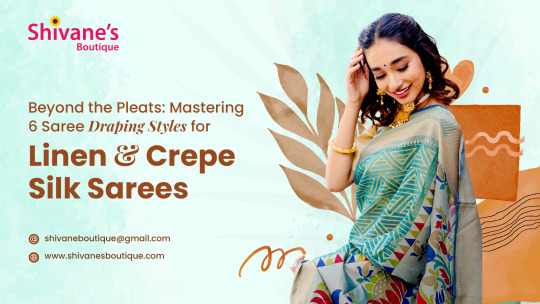
The Nivi Drape: This is a traditional Indian style of draping a sari with sophisticated curtain pleats that complement the smooth feel of crepe silk sarees.
Here’s how you do this:
Create pleats in the pallu ranging from 1 to 2 inches in size.
Pin the folded pallu on your right shoulder.
Wrap the rest of the saree around your waist, folding neatly and securing firmly at your belly button.
Drape the remaining pallu over your left shoulder to create a waterfall effect (adjust as needed for the volume).
The Bengali Drape: This particular drape design shows a classic elegance and is perfect for the luxurious flow of a crepe silk saree.
Here’s how you do this:
Create reduced folds in the loose end of the sari compared to the Nivi style.
Secure the folded end of the saree over your right shoulder.
Fold and secure the leftover saree fabric into smaller pleats around your belly button.
Unlike Nivi style, drape a portion of the pallu over the left shoulder, while neatly tucking in the remainder for a polished appearance. Draping Styles for Linen Sarees
The Mulmul Drape: Linen sarees, known for their crisp feel, are perfect for the Mulmul drape.
Here’s how you do this:
Create only 4-5 tiny folds on the pallu.
Secure the folded end of the saree on your right shoulder.
Fold and secure the leftover saree with little pleats around your belly button.
To achieve a neat appearance, fold the pallu entirely under your right arm towards the back, instead of draping it over the shoulder.
The Gujarati Drape: This particular draping style is famous for its comfortable adjustment and is ideal for the airy feel of linen sarees.
Here’s how you do this:
Create folds of medium size in the pallu.
Fasten the folded end of the saree on your right shoulder.
Wrap the remaining saree around your waist and create comfortable pleats at your waist.
To achieve the Gujarati style, drape the pallu over your left shoulder, displaying only the border and neatly tuck in the remaining fabric.
Draping Styles for Tussar Sarees
The Leheriya Saree Drape: Tussar sarees, known for its earthy feel, are perfect for the Leheriya drape. This drape style features beautiful waves or "lehers" created in the pallu.
Here’s how you do this:
Opt for a pre-pleated saree or make accordion pleats on the pallu.
Pin up the folded pallu on your right shoulder.
Fold and secure the leftover saree with tidy pleats around your waist.
Allow the pre-pleated lehers to hang down your back, adjusting for volume.
The Gondhwal Saree Drape: This style of drape originates from the Gond tribe known for its artistic flair. It's a perfect choice for Tussar sarees.
Here’s how you do this:
● Create medium-sized folds in the pallu.
● Fasten the folded pallu with a pin on your right shoulder.
● Fold and secure the leftover saree with neat pleats around your waist.
● To create a dramatic effect, wrap the whole pallu around your left shoulder.
There are many saree draping styles available, and the ones mentioned are just a few examples. With some practice, you'll quickly become skilled at draping a saree in different styles, confidently flaunting these timeless drapes!
Shivane’s Boutique - Your Destination for Sarees & Material Collections
Shivane's Boutique proudly features a carefully selected range of sarees sourced from renowned weaving craftsmen across India. Additionally, they offer a range of cotton salwar materials and ready-to-wear choices ideal for women who appreciate ethnic style. If you're a woman seeking to enhance your wardrobe, shivane's boutique is the best choice.
For more: Beyond the Pleats: Mastering 6 Saree Draping Styles for Linen & Crepe Silk Sarees
0 notes
Text
How to Choose the Best Indian Painting for Your Home’s Hallway
Introduction
Paintings are a great way to add colours to dull hallways, transforming them into vibrant spaces that tell a story. Imagine walking into your home and being greeted by the rich heritage of Indian art, the intricate details of traditional Indian paintings, or the bold strokes of modern art. Each painting is more than just a decorative piece; it’s a conversation starter, a reflection of your taste, and a statement about your love for art.
In this blog, we will guide you on how to choose the perfect Indian art painting that not only enhances the beauty of your hallway but also resonates with your personality. So, let’s embark on this colourful journey together!
Types of Indian Paintings[1] [2] [3]
Madhubani Paintings: Originating from the Mithila region of Bihar, Madhubani paintings are characterised by their eye-catching geometric patterns and vibrant colours. They often depict scenes from Hindu mythology, nature, and everyday life. In a hallway, a Madhubani painting can add a burst of colour and a touch of tradition. Its intricate details can captivate visitors and spark conversations.
Warli Paintings: Warli paintings come from the tribal regions of Maharashtra. They are simple and elegant, using a basic circle-and-triangle pattern to depict various scenes of social and cultural life. A Warli painting in your hallway can bring a sense of calm and simplicity. Its minimalistic design can complement modern decor while adding a hint of rustic charm.
Gond Paintings: Gond paintings are a form of tribal art from Madhya Pradesh. They are known for their rich detail and bright colours. Gond paintings often depict scenes from folklore and the natural world. A Gond painting can make your hallway come alive with its vivid imagery and storytelling. It can serve as a striking centrepiece that draws the eye.
Rajasthani Miniature Paintings: Miniature paintings from Rajasthan are renowned for their intricate detail, vibrant colours, and elaborate themes, often depicting royal life, love stories, and scenes from Hindu epics. A Rajasthani miniature painting can add a royal touch to your hallway. Its rich colours and detailed imagery can create a luxurious feel.
Pattachitra Paintings: Pattachitra is a traditional painting form from Odisha, known for its intricate details and mythological narratives, especially inspired by Jagannath and Vaishnava sects. A Pattachitra painting can infuse your hallway with a divine touch. Its spiritual themes can create a serene and peaceful ambience.
Choosing the Right Painting
Choosing the right Indian painting for your hallway is a personal journey that reflects your taste, personality, and the ambience you want to create. Here are some factors to consider:
Size: The size of the painting should be in proportion to your hallway. A large modern art painting can be a statement piece in a spacious hallway, while smaller paintings can create a gallery effect in a narrow space.
Colour Scheme: The colours in the painting should complement the existing colour scheme of your hallway. You can choose a painting with contrasting colours to create a focal point or select one with similar tones for a harmonious look.
Style: The style of the painting should align with your home decor. If your home has traditional Indian decor, you might opt for Madhubani or Warli paintings. For a modern look, you could consider modern art paintings of abstract art.
Theme: The theme of the painting can set the mood for your hallway. Landscape oil paintings can bring a sense of tranquillity and nature to your home. On the other hand, paintings depicting scenes from Indian mythology can add a touch of culture and heritage.
Personal Resonance: Most importantly, the painting should resonate with you. It should be a piece that you love and enjoy, as it’s something you’ll see every day.
Best Indian Painting Suggestions
1. Buddha Blessing Hand Painting
2. Varanasi Ghaat Painting
3. Radha Krishna with Cows

Conclusion
Choosing the right Indian painting for your home’s hallway is an exciting journey that combines your personal taste, the aesthetics of your home, and the rich tapestry of Indian art. Whether you choose a vibrant Madhubani painting, a serene landscape oil painting, or a bold modern art piece, the right artwork can transform your hallway into a captivating gallery of your own.
0 notes
Text
Exploring the Rich Tapestry of Gond Art: A Dive into the World of Gond Paintings
Introduction:
Gond art, a traditional form of Indian tribal art, has gained recognition and appreciation on the global stage. Rooted in the rich cultural heritage of the Gond tribal community, these intricate paintings tell stories of nature, folklore, and spirituality. In this blog, we will delve into the captivating realm of Gond art, exploring its origins, techniques, and significance in today's art world.
I. Origins of Gond Art:
Gond art finds its roots in the Gond tribal communities of central India, particularly in the states of Madhya Pradesh and Chhattisgarh. The word "Gond" refers to both the tribe and their art form, which has been passed down through generations. The tradition of Gond painting is deeply intertwined with the tribe's connection to nature, myths, and daily life.
II. Unique Characteristics of Gond Paintings:
Vibrant Colors and Intricate Patterns:
Gond paintings are known for their vibrant and eye-catching colors. Artists use natural pigments and dyes derived from plants, creating a visually stunning array of hues. The paintings also feature intricate patterns and detailing, showcasing the artist's skill and attention to detail.
Depiction of Nature and Folklore:
Gond art predominantly revolves around nature and folklore. Animals, birds, and trees are recurring motifs, often depicted in a stylized and symbolic manner. The paintings tell stories of the Gond community's deep connection with the environment and their cultural narratives.
III. Techniques Employed in Gond Art:
Dot and Line Work:
Gond artists employ a unique technique of creating intricate patterns using dots and lines. The meticulous arrangement of these elements contributes to the overall aesthetics of the painting, giving it a distinctive look.
Nature-Inspired Imagery:
The artists draw inspiration from the natural world, incorporating flora and fauna into their compositions. The stylized representation of animals and plants adds a surreal and whimsical quality to Gond paintings.
IV. Significance in Today's Art World:
Cultural Preservation:
Gond art serves as a significant cultural identifier for the Gond community. In today's rapidly changing world, the preservation of this traditional art form is crucial in maintaining the cultural heritage of the tribe.
Global Recognition:
Over the years, Gond art has gained international acclaim, with exhibitions and collaborations showcasing the talent of Gond artists on a global platform. This recognition not only provides economic opportunities for the artists but also promotes cross-cultural understanding.
Conclusion:
Gond art, with its vibrant colors, intricate patterns, and cultural significance, stands as a testament to the rich artistic heritage of the Gond tribal community. As we appreciate the beauty of Gond paintings, let us also recognize the importance of preserving and celebrating the diverse traditions that contribute to the tapestry of global art.
0 notes
Text
Exploring the Rich Culture and Heritage of Gond Art Painting
Gond art is an Indian tribal art form that originated in the Gond tribe of Madhya Pradesh, India. This art from India has a rich cultural heritage and a unique style that has gained popularity worldwide in recent years. In this blog, we will explore the rich culture and heritage of Gond art.
Gond Art - A Brief Introduction
Gond art is a form of tribal art created using natural pigments and materials. The Gond tribe, which is one of the largest tribes in India, has been creating this art form for generations. The art form is characterized by intricate patterns and vibrant colors that depict stories from tribal life and mythology.
The History of Gond Art
Gond art has a rich history that dates back to ancient times. This art from India has been passed down through generations of the Gond tribe and was created to communicate with the gods. The art form was also used to decorate houses and other spaces, adding a touch of beauty and color to everyday life.
The Unique Style of Gond Art
Gond art has a unique style that is instantly recognizable. These Indian paintings are characterized by intricate patterns and vibrant colors, focusing on nature and mythology. Indian painters use natural pigments and materials like charcoal, cow dung, and leaves to create their artwork. The patterns in Gond art are often repetitive and symmetrical, with a strong sense of rhythm and movement.
The Significance of Gond Art in Tribal Life
Gond art holds significant importance in the lives of the Gond tribe. These Indian paintings are a way of preserving their cultural heritage and passing it on to future generations. It is also a way of communicating with the gods and seeking their blessings. The patterns and motifs used in Gond's art are often inspired by nature and mythology, reflecting the tribe's close relationship with the natural world.

The Growing Popularity of Gond Art
In recent years, Gond art has gained popularity across the world. The intricate patterns and vibrant colors have captured the attention of art lovers and collectors. The unique style of Gond art has been featured in major art exhibitions and festivals, including the India Art Fair and the Kochi-Muziris Biennale. The increasing demand for Gond art has also provided a source of income for the Gond tribe and helped to preserve their cultural heritage.
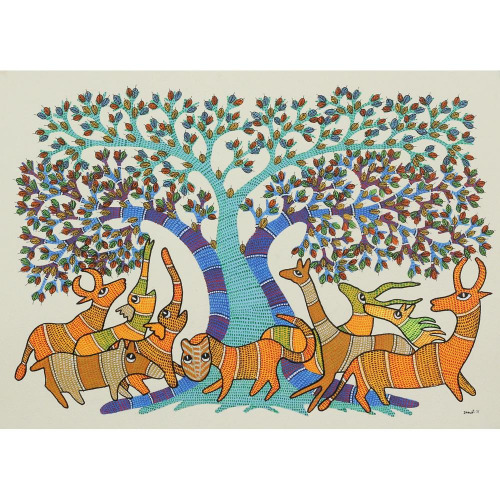
Conclusion
Gond art is a unique and vibrant artwork from India that holds significant importance in the lives of the Gond tribe. The intricate patterns and vibrant colors reflect the tribe's close relationship with nature and mythology. The growing popularity of Gond art is a testament to its beauty and cultural significance. As the art form continues to gain recognition worldwide, it provides a platform for the Gond tribe to preserve their cultural heritage and share their stories with a wider audience.
0 notes
Text
Indian tribal folk art- wall paintings
Hello there! Art of the form of communication and journaling even before the invention of words or numbers. Art ages all the way to Neanderthal man, Indian folk arts speak about the way of living and explains of aspect of people’s lives and status.
In this blog, I’d like to share my senses of various tribal wall folk arts that I’ve gained the knowledge from the art researcher Mr.Soujit Das.
Pithora

Pithora origins from the state of Madhya Pradesh and Gujarat. A salient feature of the pithora painting is the featuring of seven horses dedicated to their god ‘Pithora baba’. The name Pithora means 'god of the tribe’.
The purpose of this painting is to offer god the important necessity of people’s life I.e, grains in order to get blessed with flourishing wealth. These painting can be found in the walls of the hall as it considered to be a sacred part of the house.

The process of painting is considered to be sacred as well because they work has a guide to the household as they are painted only during special occasions like wedding and birth giving.
According to a tribal myth, rain began to fall shortly after a devotee made a vow to appease Pithora deva long ago when our planet was experiencing a drought. Then he organised the painting of Pithora devas on his house's walls. Since then, the painting has been started once desires are granted or challenges are overcome.
To know more about Pithora art use the link below.
Madhubani

Madhubani belongs to the tribal community of Mithila. This is considered to be some of the most political art forms around Indian as the way of art describes their social status.
Like every other folk art Madhubani also uses the colour from nature painted with wooden twigs and fingers. As one can see, Madhubani is believed to be given birth along with Sita from the mythology. It is also believed that Mithila painters are commissioned to paint at weddings of people holding higher statuses during the wedding season like Sita’s father Kinda Janak did during her wedding.
Only the people of high class were allowed to use colour in their painting and people from outskirts and under privileged were only allowed to draw in black and whites.


Only in recent years we’ve started appreciating this particular art.
Gond

Gond art belongs to the Gond/Kond tribes of India. It means green mountains. Gond people were the believers of nature and they appreciated every single thing the nature had to offer the mankind.
The colours used in these paintings are highly vibrant and contrasting as a visual element. They used all organic colours sourced from the nature like plant leaves, sap, charcoal and cow dung.
Gond art also depicted people’s dream and their living. In Gond, we can see trees everywhere especially Mahua- tree of life which they also worshiped

The evident of piece of art Gond offered was the amount of fantasy characters they portrayed in their paintings like animals and beasts

To learn more about Gond art:
I would like to conclude this blog with these brief introduction of wall paintings from Indian tribal regions. Thank you for reading my blog.
1 note
·
View note
Text
Why Gond Art is different from other styles?

We Indians are so lucky to have a rich cultural heritage that has played a huge part in shaping up the country as to how it is today. Our monuments, religions, scriptures, geographical diversity, languages, dressing styles, paintings, etc. all have been varied and attractive even to foreigners. One such painting style worth mentioning is the Gond Art.
One of the largest tribes of central India, the Gonds, created this beautiful art form. Their rock paintings dating back to the Mesolithic period have been discovered. There are many reasons why Gond Art is different from others. The rich mythological beliefs of the Gondi people have influenced their art forms. They express their pleasure to their deities via their paintings. Their most important god, Badadev, is symbolized via a Shaja tree and another important god, Thakurdev, is associated with the Pakri tree. Thus, these trees are more often found in Gond art. You will also find more of other flora and fauna in their paintings.
The one big thing which is immediately noticeable in the Gond art is the huge amount of lines, dah, and dots in it. The lines are drawn in the paintings in such a way that they impart a sense of movement in the paintings to the viewer. The colors used are also bright and vivid. Because of the dots, dashes, not much color is required to use.
The Gond paintings also depict stories of the people, their lives, their relationship with nature, etc. as most of these paintings were done during their festivals and ritual celebrations, these events are also seen in their paintings. One more big reason why Gond art is different than other art forms is the way that the modern world discovered it. Gond art remained oblivious to the world until the 1980s. At that time, Jagdish Swaminathan, a renowned artist and newly appointed director of Bharat Bhavan art center in Bhopal, sent scouts in the hinterland to discover hidden art forms. That way he discovered Gond Art, courtesy of Jangarh Singh Shyam, a highly talented 17-year-old boy, painting his house external walls by Gond Art. Practicing the Gond art is really fun. Today it is known all over the world. Truly, the beauty of Gond art can't be fully described.
Penkraft conducts classes,course, online courses ,live courses ,workshops ,teachers' training & online teachers' training in Handwriting Improvement, Calligraphy, Abacus Maths, Vedic Maths, Phonics and various Craft & Artforms - Madhubani, Mandala, Warli, Gond, Lippan Art, Kalighat, Kalamkari, Pichwai, Cheriyal, Kerala Mural, Pattachitra, Tanjore Painting, One Stroke Painting, Decoupage, Image Transfer, Resin Art, Fluid Art, Alcohol Ink Art, Pop Art, Knife Painting, Scandinavian Art, Water Colors, Coffee Painting, Pencil Shading, Resin Art Advanced etc. at pan-India locations. With our mission to inspire, educate, empower & uplift people through our endeavours, we have trained & operationally supported (and continue to support) 1500+ home-makers to become Penkraft Certified Teachers? in various disciplines.
0 notes
Photo

(630)
realityayslum: Peter Henry Emerson The Compleat Angler, 1888 Plate XXV Footbridge Near Chingford, Via Art of the Photogravure; nostalgia1010-blog: y =fictionist [S. Mash]; heracliteanfire: Marais de Saint-Gond, Marne, 1949. René-Jacques (aka), René Giton (via Réunion des musées nationaux)
(via triptychon64)
Visit me on triptych193.wordpress
2 notes
·
View notes
Text
I propose Bhajju for a name <3
also I looked up Gond names and went down a rabbit hole of information so here are some websites about the Gond tribes and their religions if y’all are interested
https://www.downtoearth.org.in/news/seven-brotherhoods-and-the-love-of-trees-animals-and-birds-46698
https://en.wikipedia.org/wiki/Gondi_people
https://www.artisera.com/blogs/expressions/14-important-gond-artists-who-are-promoting-the-tribal-art-form
Rendering the tiger (we need a name for that baby) unconscious was Bheem’s last resort?!🥺
64 notes
·
View notes
Photo
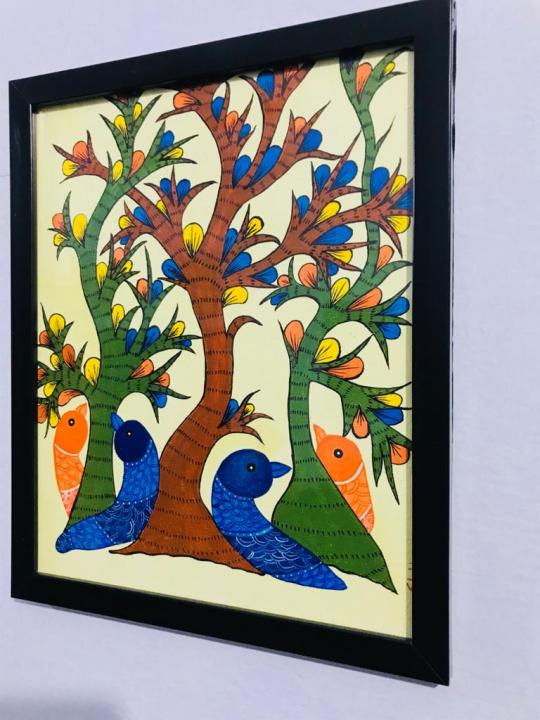
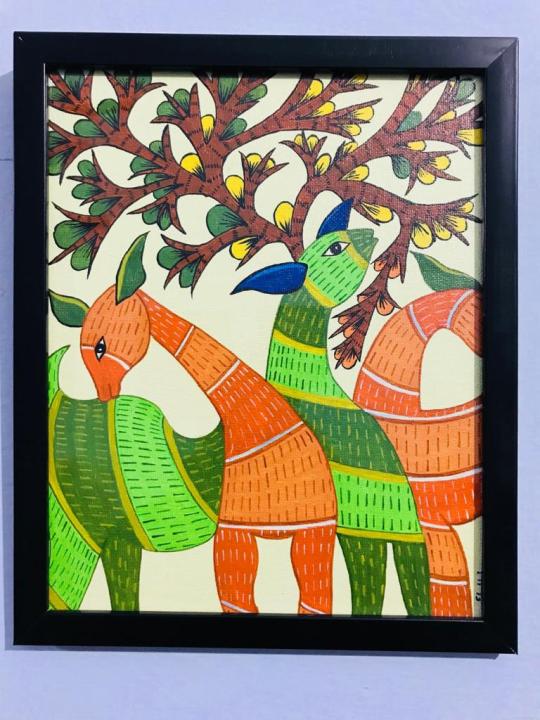
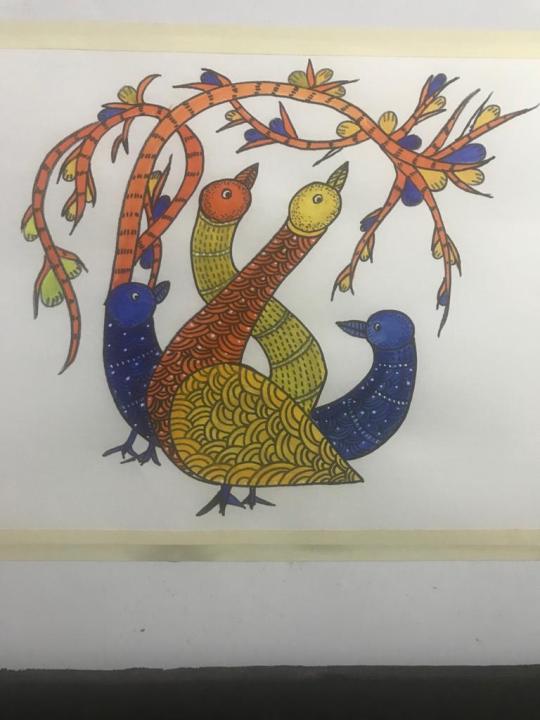
Gond Art paintings
Gond painting price, information, tutorial, images, history and gond art techniques
Today's Gond paintings have become quite popular because of the efforts by the Govt of India to promote and showcase the beauty of tribal art.There have been expo of Gond paintings in many region of the world . Gond paintings price between Rs 3000/- to Rs 50000/-
Today , many talented Gond artists works including Shubhi Jain can be seen on canvases in art galleries internationally.
Shubhi Jain mainly preferred the tree of life surrounded by deer figures .She features different kinds of birds too , while her signature pattern is tree almost erect and still . She takes 3 -21 days to make each painting.
In the eyes of a Gond artist , everything is sanctified and intimately connected to nature . Thus ,the unique oral narrative tradition of the Gond art is reflected in their paintings as well The work of Gond artists is rooted in their culture , and thus story - telling is a strong element of every painting .
However every artist today has a personal style and has developed a specific language within these narratives creating a richness of artfully forms and styles.
Who are Gond Tribes ?
Gond are one of the largest tribes in india and are Dravidian's whose origin can be traced to the pre -Aryan era , who are mainly from Madhya Pradesh and also found in some place of Andhra Pradesh , Maharashtra , Chhattisgarh and Odisha
The word gond comes from kond which means green mountains in the Dravidian idiom. About half of Gonds speak Gondi Languages , While the rest speak Indo - Aryan languages including hindi.
The Gond are also knowns as the Raj Gond The term was widely used in 1950s , but has now become almost obsolete , probably because of the political eclipse of the Gond Rajas. The Gondi language is closely related to Telugu , belonging to the Dravidian family of languages.
The recorded history of the Gond people goes back 1400 years , but considering that they inhabit areas where rock paintings dating to the Mesolithic have been found , their antecedents probably date back even further .
Many of the Gonds customs echo that of their Mesolithic for bearers .An obvious example of this is the custom of embellishing the walls of their houses , an activity that may originate in cave - habitation tradition of their forefathers.
What are the main festivals of Gonds ?
The Gonds paint their walls on festive juncture such as karva Chauth , Diwali , Ashtami , and Nag Panchmi , Gond painting delineate various celebrations ,rituals and man's connection with nature . The artists use natural colors extract from charcoal , colored soil , plant sap , leaves and cow dung .
How is Gond art made ?
Gond paintings can be best be described as 'on line work'. The creator makes sure to draw the inner as well as outer lines with as much care as possible so that the perfection of the lines has an immediate effect on the viewer .
Lines are used in such a way that it conveys a sense of movement to the still images . Dots and dashes are added to impart a greater sense of movement and increase the amount of detail.
In current scenario gond paintings aren't painted on walls and floors and are instead painted on canvas. easy to transport , carry and hang on a wall .
Due to paucity of natural colors in the current age , Gond artists have started to use poster colors .This combined with the use of canvas has made modern Gond paintings much more chromatic than its traditional counter parts.
Gond Art technique tips by artist 'Shubhi Jain'
" Hello art lovers first draw a rough pencil sketch then draw a black outline with use of bright flamboyant colors and with the help of lines, dots and dashes try to create a pattern of design of your own"
" Conventionally , the Gond paintings were done on mud walls with colors elicited from natural materials like soil , charcoal , cow dung and leaves "
" Most important Gond paintings as ' on line work '. Art is created out of carefully draw lines. Lines are used in such a way to convey a sense of movement to still images"
Quote by Gond artist 'Shubhi Jain'
" A painting shows a journey of artist without words"
This blog exclusively sponsored by ' THE NEON ART ACADEMY '
#gondart#gond painting#gond tribe lifestyle#gond art tree#gond art deer#gond art peacock#gond art birds#artsy#ArtGallery#artists on tumblr#ArtMuseum#painting#painter legend
0 notes
Text
The Vernacular on the ground in Madhubani
I needed to come back to the blog on the occasion of the International Delhi Art Fair in New Delhi that took place Feb 2 - Feb 5, 2017. Unfortunately I was unable to attend the event and so missed the exhibition of Vernacular art curated by art historian Annapurna Garimella which included Gond, Mithila and Mysore artists. Though space was limited, the exhibition offered much needed exposure for India’s indigenous art forms.
Here I would like to present six artists whose work I think truly shows what is happening on the ground in Mithila art: the excitement of experimentation and the search for a personal artistic path in the face of social and technological changes.
Avinash Karn ‘Munna, Smile Please’, 36″x24″, acrylic on canvas, 2016.
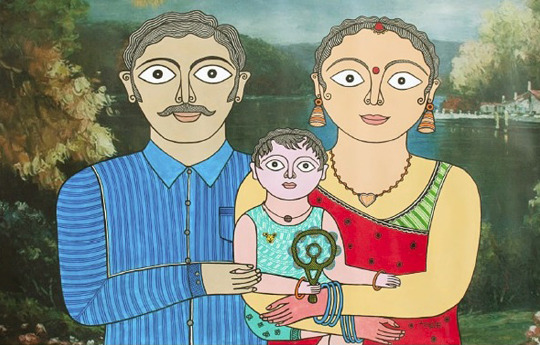
Avinash Karn studied art at Banaras Hindu University and then spent the last couple of years sowing the seeds of Mihtila art in India: painting Mithila-style hotel murals in Gurgoan, teaching the basics of the art to tribals in Jharkhand, holding Mithila workshops in Goa. In this piece he photo-shopped a traditional photographer’s studio backdrop onto canvas and then painted the portraits in the areas left blank. Combining traditional photography practice with current day digital manipulation and finishing with a painted portrait in the Mithila style not only gives an engaging picture of a middle-class family in today’s India but also presents the options, choices and tools Mithila artists have at their disposal today.
Mahalaxmi and Shantanu Das, ‘Kohbar Monologues No 2′ , 22″x30″, acrylic on paper, 2016.
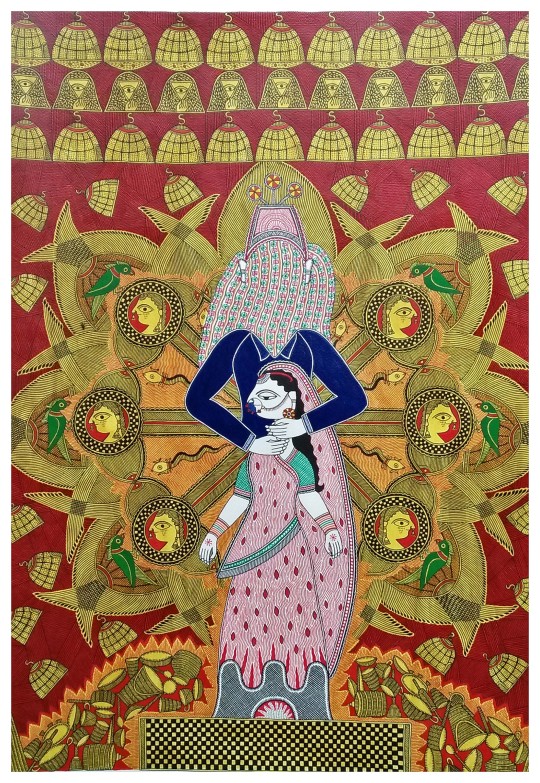
A chilling piece of theater. The husband in traditional bridegroom headdress chokes his wife as flames reach up her sari from the household cooking fire. The rich, thick, blood red color adds a quiet horror to the scene while the lotus pond wedding kohbar is deconstructed here as a wheel of torture, the lotus flowers the tearful faces of brides. Bamboo representing the male lineage becomes scythes that surround and further entrap the unfortunate young wife. On high, old women peer through their saris at a scene they are helpless to prevent.
The traditional kohbar symbols painted on the walls of the wedding chamber represent the hope of a fruitful and happy marriage. Here they become instruments of oppression and death. A powerful painting dealing with a reality that manifests itself in various guises in contemporary Indian society. Though this artist team had a large canvas work in the exhibition in Delhi, this painting is extraordinary and a must in any exhibition of contemporary Mithila art.
Shalinee Kumari . At age 23, via the Mithia Art Institute in Madhubani, Shalinee Kumari made the journey from the small village of Baxi Tola near the Nepal border to San Francisco for her one woman show. After a two week stay in the States she returned to India, married, and now lives in Hyderabad with her husband and daughter where she teaches and continues to paint.
Betiyaan Parayi Hoti Hai (Daughters Are for Others), 30″x22″, acrylic on paper, 2016.
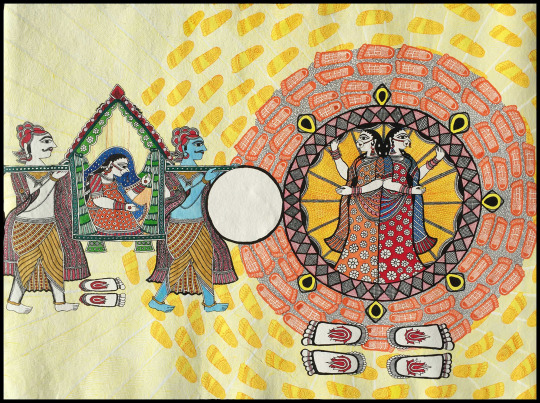
The bride carried to the husband’s home loses not only her birth family but also has no rights in her husband’s family. This is the patriarchal tradition. Shalinee Kumari is not the first to ask why this must be so, as songs on You Tube attest, but she is the first Mithila artist to so elegantly limn this tradition. The footprints go in circles, in both directions. They point back to the old family and forward to the new. They search for an answer. And as in the songs there is no answer. At least not yet.

Amrita Jha is an accomplished artist and a Mithila Art Institute graduate. Though currently at work on a series of bird paintings much of her art is informed by the problems of being a woman in a highly patriarchal society. Here her The Curses Begin, 40″x33″, acrylic on paper, 2016.
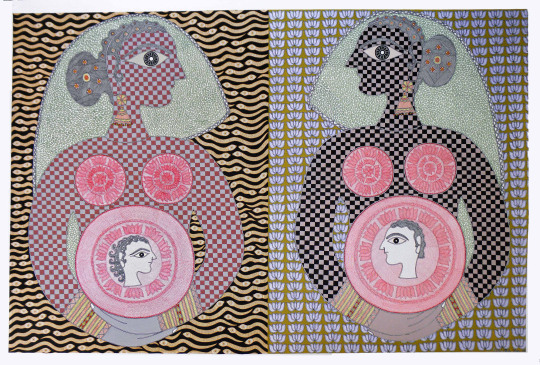
“Usually, a mother-in-law starts to curse the day she knows that her daughter-in-law is carrying a girl child in her womb and becomes extremely happy if she is carrying a male child.” Amrita Jha

Unmatched in her attention to line,color and detail, Amrita Jha here gives us a stylized, formal portrait of two beautiful young women, facing each other, nearly identical mirror images except for the background behind each: one a wall of light purple lotus flowers while the other a field of undulating golden snakes. The gems in their perfectly coiffed hair, their golden earrings, the multiple colored bracelets on both wrists and their shimmering saris give them a somewhat haughty air which is softened by their clasped hands tenderly supporting their yet to be born son and daughter. Both mothers, both awaiting the birth of their child.
But note how, reflecting popular sentiment, the artist’s choice of the vertical gives the boy child’s mother a height and authority denied to the mother holding the daughter. The vertical rows of lotus flowers continue up to the heavens while the horizontal lines of snakes create a visual field that surrounds and entraps this mother and her future daughter. The sex of the child also reflects back onto the mother where the darker, contrasting colors of the figure cradling the boy give that figure, a presence, a self assurance that is lacking in the mother-daughter figure with its slightly anemic colors.
The Curses Begin is a well conceived and well crafted piece exhibiting the best of traditional Mithila Kachni Bharni (line and color) painting .
Naresh Kumar Paswan: To complete my selection of current Mithila Vernacular painters I must also include Naresh Kumar Paswan. He is a unique, self-taught talent whose work resembles no other. All in black pen and ink with geometric lines that make his work seem a handcrafted woodcut, he paints scenes from Indian stories as well as nature. If Surya the sun God appears a bit fierce in this piece, that is deliberate. Naresh says that in the middle of the Indian summer, out in the villages, the sun is anything but your friend.
Sun and Pond 22″x30″, acrylic on paper, 2014.

I suggest that these are some of the most interesting artists working in Mithila art today. Some already accomplished but still relatively unknown, while others are just ‘emerging’ as the galleries say. For now the Vernacular in Mithila/Madhubani art lies with them.
5 notes
·
View notes